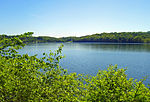Lake Carmel (New York)
1928 establishments in New York (state)Commons category link is locally definedProtected areas of Putnam County, New YorkReservoirs in New York (state)Reservoirs in Putnam County, New York

Lake Carmel is a small manmade lake located in the Town of Kent, in Putnam County, New York. It takes its name from the nearby town of Carmel, and in turn gives it to the community of Lake Carmel surrounding it. The lake was created by developers in the early 20th century by damming the Middle Branch of the Croton River. It is one of the few sizeable bodies of water in the county not a part of the New York City water supply system, but its outfall goes straight into the system's Middle Branch Reservoir downstream in the town of Carmel. Due to increasing development around the lake, the city has helped the community improve its wastewater treatment.
Excerpt from the Wikipedia article Lake Carmel (New York) (License: CC BY-SA 3.0, Authors, Images).Lake Carmel (New York)
Lakeshore Drive East, Town of Kent
Geographical coordinates (GPS) Address Nearby Places Show on map
Geographical coordinates (GPS)
| Latitude | Longitude |
|---|---|
| N 41.459722222222 ° | E -73.665 ° |
Address
Lakeshore Drive East
Lakeshore Drive East
10512 Town of Kent
New York, United States
Open on Google Maps










